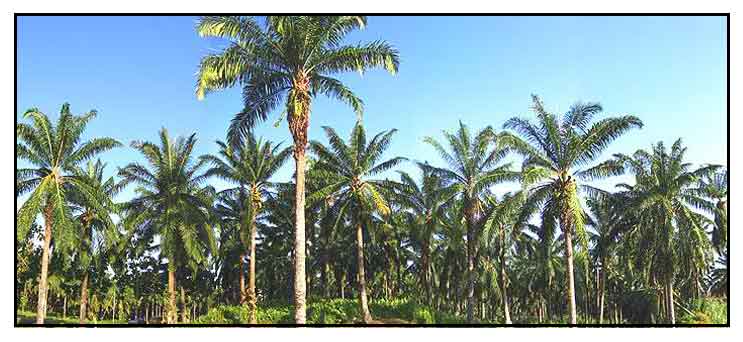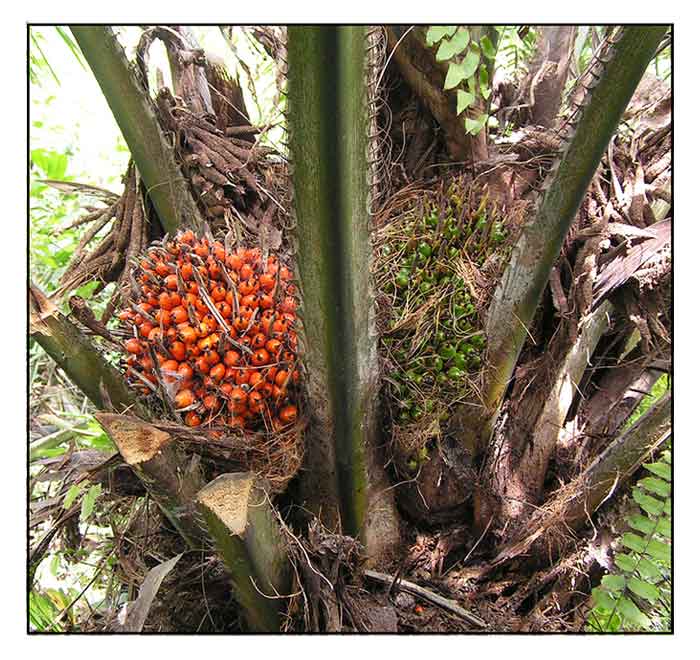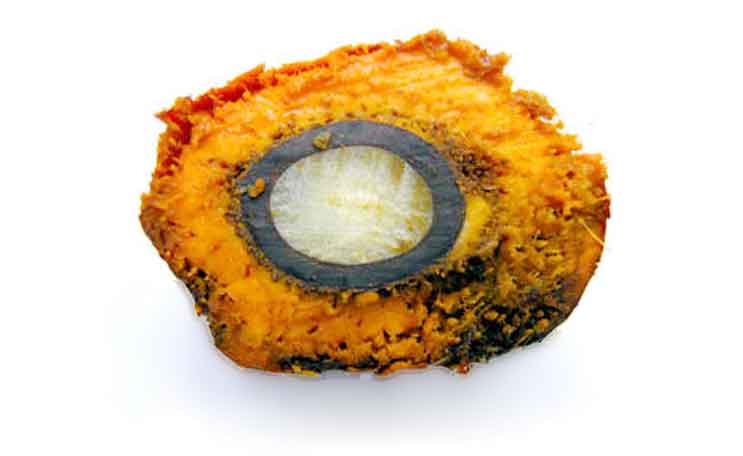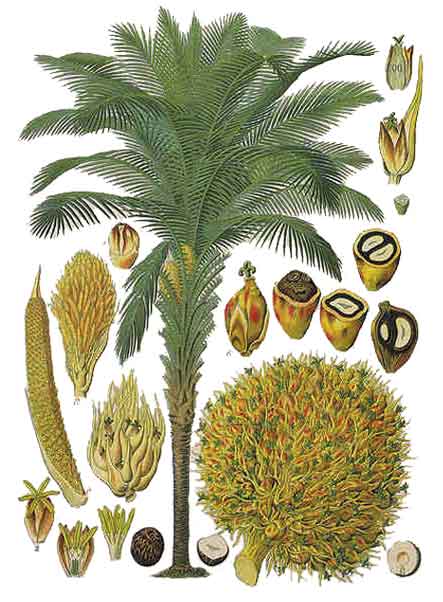 Gen info Gen info
- Elaeis guineensis is the principal source of palm oil.
- Human use of oil palms may date as far back as 5,000 years in Egypt. In the late 1800a, archaeologists found palm oil in a tomb at Abydos dating back to 3000 BCE. (36)
- The first Western to describe it and bring back seeds was French naturalist Michael Adanson. (36)
- Each hectare of oil palm, which is harvested year round, yields an annual production average of 20 tonnes of fruit, yielded 4,000 kg of palm oil and 750 kg of seed kernels yielding 500 kg of high-quality palm kernel oil, along with 600 kg of kernel meal, which is processed for livestock feed.
(36)
- The genus name Elaeis is Greek for 'oil'. The specific epithet guineensis refers to the name for the area, Guinea, not to the modern country bearing that name.
 Botany Botany
Oil palm tree has an erect trunk reaching a height of 4 to 10 meters. Leaves are numerous, 3 to 4.5 meters long. Petioles are broad, armed on the sides with spinescent, reduced leaves. Leaflets are numerous, linear-lanceolate, nearly 1 meter long, 2 to 4 centimeters wide. Male inflorescence is dense, having numerous, cylindric spikes which are 7 to 12 centimeters long and about 1 centimeter in diameter; the rachises excurrent as a stout awn. Female inflorescence is dense, branched, 20 to 30 centimeters long, the flowers densely disposed. Fruit is borne in large dense masses.
Distribution
- Introduced sometime in the middle of 19th century.
- Ornamental cultivation in Manila and larger towns.
- Seeds of improved strain introduced by Dr. Eduardo Quisumbing in 1938 from Kuala Lumpur.
- Grown extensively in West Africa, its original home, and in Malaya, Sumatra, Java, India, and the United States.
 Constituents Constituents
- Palm yields two kinds of oil: the palm oil and palm-kernel oil.
- Palm oil consists principally of palmitin and olein, used primarily in the manufacture of soaps and candles.
- The palm kernel oil consists chiefly of glyceride of lauric acid, together with palmitic, oleic and myristic acids, some caprylic acid, capric acid and phytosterin, and used for making vegetable butter.
- Phytochemical screening of oil palm leaves yielded phenolic compounds such as flavonoids, tannins, coumarins, alkaloids, saponins, terpenoids, steroids, and carbohydrates. (see study below) (17)
- Proximate analysis of methanolic extracts showed flavonoids as main constituents highest in oil palm leaves (257.00 ± 3.055 mg QE/g DW).
(see study below) (17)
- Analysis of lipid and sterol composition of the pollen yielded triglycerides, esterified and free sterols and trace amounts of hydrocarbons from the neutral lipid fraction. Major fatty acids were linoleic, palmitic, linolenic acids with small to trace amounts of oleic, stearic, arachidic, myristic, lauric, palmitoleic and margaric acids.
- Phytochemical analysis of leaf extracts yielded secondary metabolites including alkaloids, flavonoids, tannins, and saponins. Flavonoids was highest in the methanol extract (118.03 ± 0.29) and least in the hexane extract (8.00). (see study below)
(32)
- Study of methanolic extract of shell waste yielded phenolics (11.4 ± 0.2 g/100g),
flavonoids (5.67 ± 0.23 g/100g), tannins (6.67 ± 0.12 g/100g), terpenoids (4.53 ± 0.12 g/100g), saponins (1.99 ±0.01 g/100g), and alkaloids (1.81 0.03 g/100g).
 Properties Properties
- Considered vulnerary, laxative, diuretic.
- Antioxidant, antimicrobial, anticancer, hepatoprotective, wound healing.
- Studies have suggest antimicrobial, wound healing, hepatoprotective, antihypertensive, antioxidant, renoprotective, anticancer, antiaging, antidiabetic, antimalarial properties.
Parts used
Oil, fruits, roots, sap.
Uses
Edibility
- Edible palm heart and fruit.
- Sap from inflorescence used to make wine and sugar.
Folkloric
- Not known medicinally in the Philippines.
- In Guinea, oil is applied to wounds as a vulnerary.
- Used as a liniment for rheumatism.
- Decoction of root or burnt powder of root taken orally to treat epilepsy.
- Infructesence mixed with ginger burned and applied as enema to young children to encourage walking at an early age.
- The Bubis of the Island of Fernando Po make a poultice made from oil which is applied to wounds.
- In traditional African medicine, various plant parts used for treating gonorrhea, menorrhagia, rheumatism, bronchitis, headache, skin infections, and to promote wound healing.
(25)
- In Ghana, roots used for sexual impotence, as aphrodisiac
- In Equatorial West African, roots used as diuretic and fresh sap as laxative.
- In South Eastern Nigeria, used for treatment of boils and skin infections. Also used as vermifuge, diuretic, and poison antidote. Roots, stems bark, kernel and palm oil used for treatment of malaria, diarrhea, asthma, measles, mental disorder, and convulsions. (25) Sap from palm oil tree used by Igbo mothers planning to breastfeed to induce and sustain lactation a few hours after delivery. (30)
- In the Jola of the Garmba, West Africa, oil used for snake bites.
- In Ghana, used for the treatment of malaria.
Others
- Oil: Palm oil chiefly used in the manufacture of soaps and candles. The palm-kernel oil is used for making vegetable butter.
- Wine: In Africa, wine made from the trees.
- Ritual / Superstition: Inflorescence burned to drive away bad spirits. Seed nut used in oracle rituals for diagnosis of illness and fate dreams. (17) In southwest Nigeria, traditional healers believe in the power of the shell for the treatment of illnesses attributed to god of Satan (esu). (35)
-
Repellent: In the Jola of the Gambia, West Africa, male flower is burned to repel mosquitoes. (18)
- Fodder: Kernel meat provides livestock feed.
- Others: Palm parts used for making brooms and fish traps.
Palm oil
• Oil palm is considered the highest yielding oil-bearing crop.
• Oil is extracted from the fruit pulp (palm oil) and the kernel (palm kernel oil). For every 100 kg of fruit bunches, 22 kg of palm oil and 1.6 kg of palm kernel oil can be extracted.
• It has a high oil yield (7,259 liters per hectare per year), high levels of natural antioxidant, and comparatively cheaper pricing.
• It has more saturated fats than canola, corn linseed, soybean, safflower and sunflower oils and can withstand deep-fry heat, with a resistance to oxidation.
 Studies Studies
• Wound Healing / Antimicrobial: Phytochemical screening yielded tannins, alkaloids, steroids, saponins, terpenoids and flavonoids. The extract showed significant activity against C albicans. Results show a potent wound healing capacity as evidenced by better wound closures, improved tissue regeneration and histopath evidence, with a significant reduction of microbial count. (2)
• Antimicrobial: Traditionally extracted palm oil and palm kernel oil, tested individually on five microorganisms - S aureus, E coli, P aeruginosa, C albicans and A niger - showed inhibition. When the extracts were mixed, only E coli was minimally inhibited. (3) Study methanol extract of oil palm leaf for showed significant antimicrobial activity against Gram positive and Gram negative bacteria and yeast and fungi tested. (18)
• Lipid Oxidation: Supplementation of palm oil as an antioxidant to a certain extent reduced lipid oxidation in healthy rats; but worsened or not significantly inhibited in diabetic rats. (4)
• Hepatoprotective / Paracetamol Toxicity / Leaves: Study evaluated the hepatoprotective activity of E. guineensis against paracetamol- induced liver injury in mice through serum analysis. Mice treated with leaf extract showed significant decline in ALT, AST, and bilirubin levels. The hepatoprotection was attributed to an antioxidant activity. (8)
• Wound Healing / Leaf Extract Ointment: Study of E. guineensis leaf extract showed potent wound healing capacity as evidenced by better wound closure, improved tissue regeneration, together with histopath improvement. (10)
• Antihypertensive and Cardiovascular Effects / Catechin-Rich: Study evaluated the catechin-rich oil palm leaf extract (OPLE) for antioxidant, antihypertensive, and cardiovascular effects in normal and NO-deficient hypertensive rats. Results showed significant attenuation of blood pressure increases, increased serum NO, reduced lipid peroxidation, and antioxidant effects. (11)
• Cytotoxicity / Anti-Cancer: Study evaluated the cytotoxic effects of a methanol extract on MCF-7 and Vero cell. Results showed significant cytotoxic effects on MCF-7, suggesting a potential use of the extract in preparing recipes for cancer-related ailments. (12)
• Antioxidant / Renoprotection in Diabetes: Results of study of oil palm leaf extract (OPLE) showed improvement in renal dysfunction and pathology in diabetes. Renoprotection was via catechin-rich OPLE modulation of oxidative stress caused by hyperglycemic-induced generation of free radicals in the diabetic kidney and prevention of renal dysfunction and structural injury. (13)
• Acute Toxicity Study / Brine-Shrimp Lethality: Acute oral toxicity and brine shrimp lethality of a methanolic extract was tested. Results showed E. guineensis is nontoxic and safe for commercial utilization. (14)
• Antioxidant / Antimicrobial / Leaves: Study evaluated extracts of oil palm leaves for antioxidant and antibacterial activity. Antioxidant evaluation using DPPH assay showed great antioxidant activity from the methanolic extracts with IC50 value of 0.646 mg/mL. Antibacterial activity showed the methanol extract to have broad spectrum activity against all tested bacteria with inhibition zone of 7.7-11.3 ± 0.0 -1.0 mm. (see constituents above) (16)
• Anti-Aging / Antioxidant / Leaves: Study screened methanol extracts of leaves for antioxidant activity by DPPH (IC50 814 µg/ml), XOI (534.04 µg/mL), NOS 37.48 µg/mL), and HPSA (1052.02 µg/mL) assays. Total phenolic content was o.33 mg gallic equivalent (GAE) per gram of dry extract. Results suggest a potential as an anti-aging agent, with high bioaccessibility and bioavailabiity throughout the country. (19)
• Toxicity Study / Leaves: Study evaluated the acute toxicity of a catechin-rich oil palm (E. guineensis) leaf extract. No observed adverse effects were seen at 2 gm dose. There was no death even at 5 g dose, and the acute toxic injuries appeared reversible. (20)
• Antioxidant / Pro-Oxidant Effects / Leaves: Study evaluated the antioxidant and pro-oxidant effects of chronically administered high doses (1000 mg kg) of leaf extract in an animal model of diabetic nephropathy. Results showed chronic administration for four weeks attenuated renal dysfunction and development of glomerulosclerosis and tubulointerstitial fibrosis, features that are associated with DN. Suppression of increases in oxidative stress markers and fibrotic cytokine was observed. In contrast, OPLE administered for 12 weeks caused worsening of renal dysfunction, accompanied by an increase expression of one of the NADPH oxidase subunits p22phcx. Results suggest the unfavorable effects of prolonged treatment with 1000 mg/kg were accompanied by increase expression of one of the NADPH oxidase subunits. (21)
• Wound Healing / Staphylococcus aureus Infection / Leaves: Study evaluated the wound healing potential of E. guineensis leaves against S. aureus infections in Sprague Dawley male rate model using excision and infected wound models. Results showed potent wound healing ability as evidenced by improved wound closure and tissue regeneration supported by histopathological parameters and significant reduction in microbial count, along with expression of matrix metalloproteinases. (23)
• Hepatoprotective / Carbon Tetrachloride Toxicity / Oil from Fruit: Study evaluated the protective effect of red palm oil (RPO) against CCl4 toxicity in rats treated with intraperitoneal RPO diluted in olive oil. Treated rats with RPO exhibited significant (p<0.05) increase in packed cell volume hemoglobin and platelet, and dose-dependent decrease in liver enzymes (AST, ALT, ALKP) activities. Noted was significant increases (p<0.05) in GSH, SOD, and CAT in RPO treated groups. Results showed hepatoprotective effect with potential to abate the toxic effects of CCl4 on hepatorenal and hematopoietic organs in wistar rats. (24)
• Hepatoprotective / t-BHP-Induced Oxidative Hepatotoxicity: Study suggest that aqueous rooibus extract (Aspalathus linearis) and red palm oil (RPO) (Elaeis guineensis), either supplemented alone or combined, are capable of alleviating t-BPH-induced oxidative hepatotoxicity. The mechanism of protection may involved inhibition of lipid peroxidation and modulation of antioxidant enzymes and glutathione status. (26)
• Antimalarial against Plasmodium falciparum / Leaves: Study evaluated the anti-plasmodial activity of ethanolic extracts of Elaeis guaneensis leaves, A. cissampeloides stem, T. ivorensis stem bark against chloroquine-resistant strains of Plasmodium falciparum. Results showed antimalarial activity with Elaeis guineensis showing IC50 of 1.195 µg/mL, compared to artesunate with IC50 of 0.031 µg/mL. (27)
• Effect on Reproductive Indices of Male Rats / Oil Palm Sap:
Study evaluated the effect of oil palm tree sap of Elaeis guineensis on reproductive indices of 30 male Wistar rats. Results demonstrated that the intake of frozen palm sap improved fertility in male animals, but long term administration led to necrotic changes in the testes, whereas pasteurization of palm sap impacted negatively on the reproductive indices of male animals. (28)
• Diuretic / Leaves: Study evaluated the diuretic and natridiuretic activities and toxicity of aqueous extract of E. guineensis leaves in Wistar rats. Results showed a significant diuretic effect (157.16% and 169.25%) in rats treated respectively with 135 mg/kg of extract and furosemide (20 mg/kg) and a modest diuretic activity (146.32%) with dose of 202.50 mg/kg of extract. The dose of 135 mg/kg was considered best in terms of diuretic and natridiuretic activities. (29)
• Effect in Pre-Diabetes / Leaves: Study evaluated the effect of leaf extracts of E. guineensis and F. deltoidea on patients with pre-diabetes. An 8-week intervention using 500 or 1000 mg of EG and 1000 mg of FD leaf extract decreased fasting plasma glucose and insulin levels, glucose and insulin areas under the curve, and insulin resistance, and increased insulin sensitivity. The 500 mg dose of E. guineensis showed a more consistent effect on reducing glycemia than the 1000 mg dose. Results showed positive effects on glucose and lipid levels and safety for use in humans. (31)
• Antimicrobial against Salmonella Strains / in Pre-Diabetes / Leaves: Study evaluated the in vitro anti-salmonella effect of E. guineensis on Salmonella species isolated from clinically suspected typhoid fever patients and its use as alternative treatment of salmonellosis and gastroenteritis. The highest zone of inhibition (21.67 ± 1.20 mm) was observed with a methanol extract at concentration of 100 mg/;mL for Salmonella typhimurium. Ciprofloxacin showed 23.00 zone of inhibition, augmentin 4 mm. Results suggest E. guineensis is a potential source of phytotherapy in combating salmonellosis and gastroenteritis. (see constituents above) (32)
• Effect of Lactobacillus spp. on Cellular and Innate Immunity / Sap of Fresh Palm Wine: Study isolated, characterized, and evaluated Lactobacillus spp. from fresh palm wine on its in vivo effects on innate and cellular immune system using two models, namely: in vivo leukocyte mobilization rate (LMR) and delayed type hypersensitivity response (DTHR). Phenotypic characterizations showed presence of Lactobacillus brevis, L. paracasei subsp. Tolerans, L paracasei, and L. yonginensis. Results showed the four lactobacillus spp. isolated from fresh palm wine significantly affected the innate and cellular component of the immune system positively. (33)
• Vasodilatory / Leaves: Study evaluated the vasodilatory effect of aqueous crude extract of dried and powdered leaves in porcine coronary artery. Results showed the extract induces pronounced endothelium-dependent relaxations of the porcine coronary artery, which predominantly involved NO. The stimulatory effect of EGE on eNOS involves the redox-sensitive phosphorylation of ENOS at Ser1177, most likely via the PI3-kinase pathway. (34)
• Biologic Potential of Shell Waste: Study evaluated the phytochemical contents of methanolic extract of E. guineensis shell waste. Results nullifies the traditional herbalist superstitious belief about E. guineensis shell waste. The extract yielded phytochemicals that possess antioxidant, anti-inflammatory, and astringent properties that could be used in traditional wound management. (see constituents above) (35)
Availability
Commercially, as oil products.
Pellets, tinctures, dilutions in the cybermarkets.
|

![]()




 Botany
Botany

 Studies
Studies 